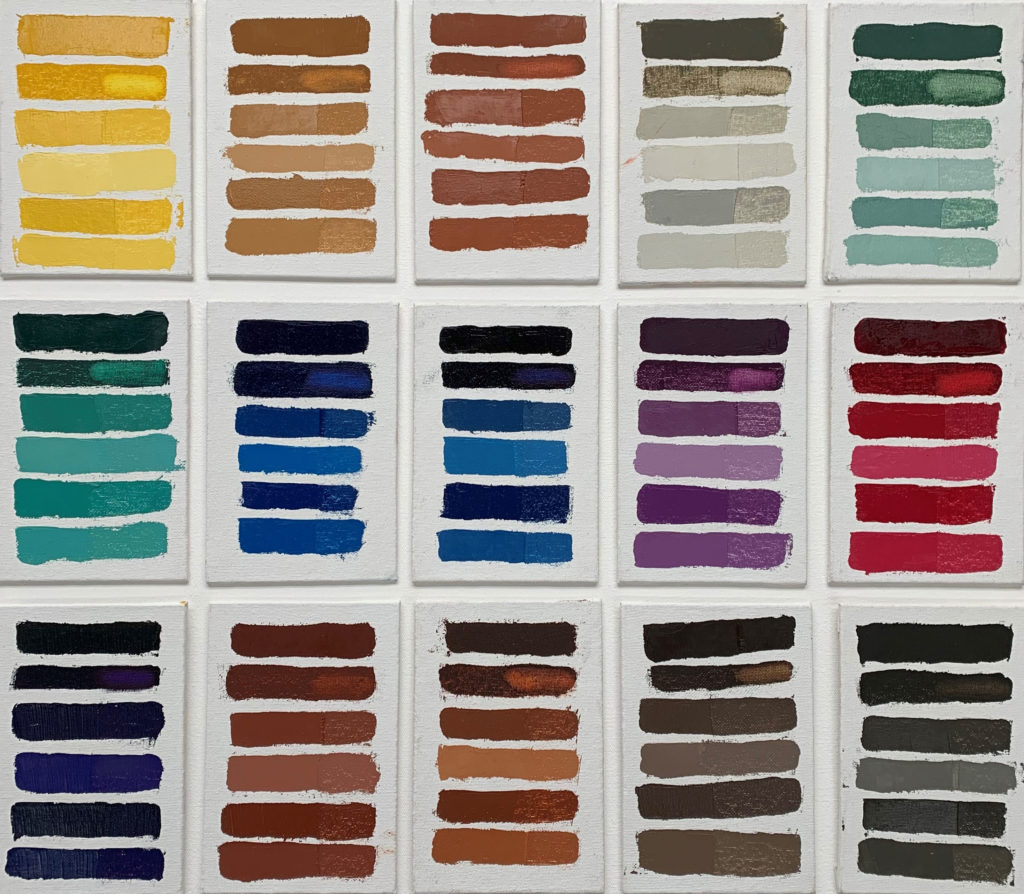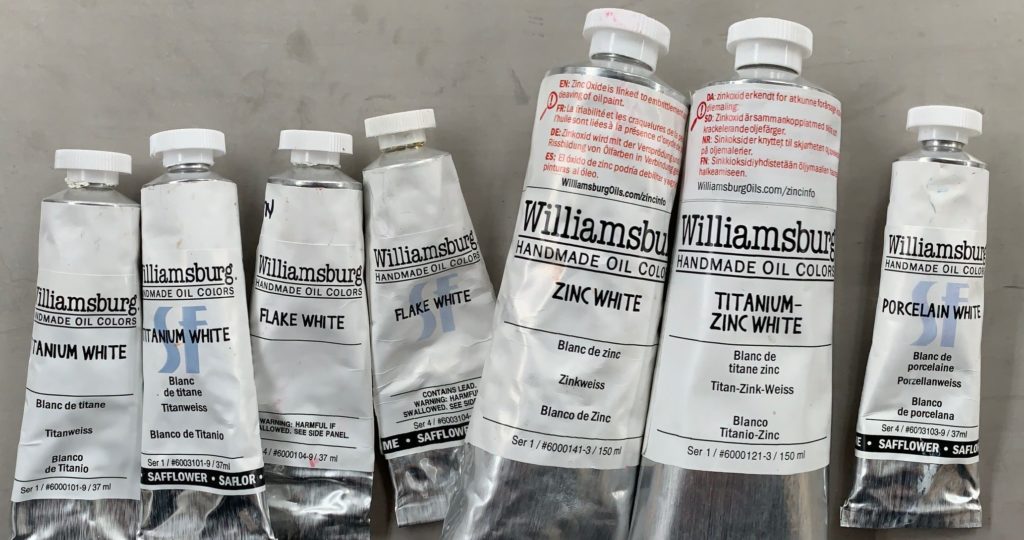
Es wird angenommen, dass Weiß bis zu 20 % eines typischen Gemäldes ausmacht. Seine Bedeutung kann nicht übersehen werden, denn es wird als Grundierung, zum Aufhellen oder Auffrischen dunklerer Farben verwendet, oder um Farben opaker zu machen. Es ist nicht nur eine entscheidende Komponente für die Farbgebung, sondern auch für die strukturelle Integrität Ihres Gemäldes, wenn man Weiß richtig versteht. Wir hielten es für sinnvoll, einen Überblick über die vielen Weißtöne zu geben, die auf der Palette von Williamsburg Oils zu finden sind.
Williamsburg bietet sieben verschiedene Weißtöne an, darunter vier auf Leinöl und drei auf Distelöl (Safflower Oil) basierende Weißtöne. Dazu gehören Titanium White, das traditionelle Flake White (Bleiweiß) und ein Weiß auf Distelölbasis namens Porcelain White, das mit einem weniger bekannten Pigment namens Lithopone hergestellt wird. Dieser Artikel befasst sich mit allen sieben weißen Farben und ihren funktionellen Merkmalen wie Abtönstärke, Farbtemperatur und Griffigkeit.

Titanweiß – PW 6 Titandioxid-Rutil-Pigment, opak, schnelle Trocknung 1-2 Tage, Lichtechtheit I
Williamsburg Titanium White wird mit einem Aalkali-raffinierten Leinölbindemittel hergestellt. Unser beliebtestes Weiß, Titanium, hat einen butterweichen Griff und eine leuchtend weiße Farbe, die leicht warm ist, wenn man sie aus der Tube drückt. Es hat eine sehr starke Abtönkraft, die bei Zugabe höherer Anteile dazu führen kann, dass Farbmischungen milchig oder cremig aussehen und in extremen Fällen verwaschen werden. Die starke Färbekraft ist zwar kein negatives Attribut, aber sie beeinträchtigt die Menge an Weiß, die einer Mischung zugesetzt werden kann, wenn eine starke Farbsättigung gewünscht wird. Titan erhöht die Deckkraft, wenn es mit anderen Farben kombiniert wird. Es ist ein sehr vielseitiges Weiß, das für Untermalungen, Alla-Prima-Arbeiten oder in den mittelstarken, oberen Schichten eines Gemäldes verwendet werden kann. Wir verwenden das Pigment Titandioxid (Rutil) in allen Williamsburg-Mischungen, die Weiß enthalten.

SF Titanium White – PW 6 Titanium Dioxide Rutile Pigment, opak, mittlere Trocknung 2-7 Tage, Lichtechtheit I
Williamsburg-Farben auf Distelölbasis sind mit einem hellblauen, durchscheinenden “SF” für Safflower Oil hinter dem Farbnamen auf dem Etikett und einem “SF” vor dem Namen in der Farbkarte gekennzeichnet. Diese Farben haben außerdem einen schwarzen Ring um das Etikett, der besagt, dass es sich um eine Farbe auf Distelölbasis handelt. In Distelöl gemahlene Farben sind dafür bekannt, dass sie auf Dauer weniger vergilben als Farben auf Leinölbasis. SF Titanium White ist spürbar heller und etwas kühler als unser Leinöltitanweiß, wenn es aus der Tube gepresst wird. Obwohl es sich ähnlich anfühlt wie sein Gegenstück auf Leinölbasis und die gleiche Farbstärke aufweist, ist zu beachten, dass Distelöl ein weniger haltbares Bindemittel ist als Leinöl. Das bedeutet, dass es am besten dünn und/oder in den oberen Schichten eines Gemäldes verwendet wird, wo seine helle weiße Farbe am besten zur Geltung kommt. Einer der Hauptgründe für die Verwendung dieser Farbe ist die Herstellung von weißen Passagen oder High-Key-Mischungen in den oberen Schichten, wo ein helles Weiß am besten zur Geltung kommt und weniger Vergilbung erwünscht ist.
HIER finden Sie einen Link zu weiteren Informationen über Williamsburg-Farben auf Distelölbasis.

Flake White – PW 1 Bleicarbonatpigment, halbdeckend, mittlere Trocknung 2-7 Tage, Lichtechtheit I
Flake White ist unser dichtestes/schwerstes Weiß. Es wird mit Leinöl hergestellt und hat eine warme Farbqualität, die in der Tube gebrochen weiß ist und den Farbmischungen eine sonnengetränkte, natürliche Wärme verleiht. Es hat eine mittlere bis geringe Abtönungsstärke, die es ermöglicht, dass Mischungen ihre Farbidentität behalten, ohne sie auszuwaschen. Der Vorteil einer geringeren Tönungsstärke in einem Weiß ist, dass größere Mengen von Mischfarben hergestellt werden können, die mehr Weiß als Farbe enthalten, aber immer noch ein gutes Chroma aufweisen. In vielen Fällen kann dies zu einer Kostenersparnis führen, aber auch Flake White hat gute Trocknungs- und Alterungseigenschaften, die es jeder Mischung verleihen wird. Flake White erzeugt einen harten, aber flexiblen Film und kann zur Haltbarkeit eines Ölgemäldes beitragen. Flake ist ein ausgezeichnetes Allzweckweiß. Es ist eine gute Wahl für die ersten Schichten eines umfangreichen Gemäldes. Es kann auch für Untermalungen, Grisaille oder zum Mischen von Farben in den oberen Schichten verwendet werden. Die mittlere Deckkraft und die mäßige Farbstärke von Flake sind besonders gut für den letzten Schliff geeignet, wenn bunte Mischungen richtig zur Geltung kommen sollen.
Hinweis zur Bleigiftigkeit – Blei kann durch Verschlucken, Einatmen von Pigmentpartikeln und durch verletzte Haut in den Körper gelangen. Dieses Produkt ist sicher, wenn es wie vorgesehen von professionellen Künstlern verwendet wird. Gemälde, die Flake White enthalten, sollten nicht geschliffen werden.

SF Flake White hat ähnliche Verarbeitungseigenschaften wie sein Gegenstück auf Leinölbasis. SF Flake kommt etwas weißer aus der Tube und mischt kühlere, weniger gelbe Farben als leinölbasierte Flake. Wie bereits erwähnt, sollten mit Distelöl hergestellte Farben langfristig weniger vergilben und besser dünn und in den oberen Schichten eines Werkes verwendet werden. Für den Aufbau eines Gemäldes mit vielen Schichten empfehlen wir, mit Farben auf Leinölbasis zu beginnen, um eine haltbarere Grundlage zu schaffen, und dann in den oberen Schichten zu SF-Farben überzugehen, um weniger vergilbende Weiß- und Farbmischungen zu erhalten.

Zinkweiß – PW 4 Zinkoxidpigment, halbdeckend, sehr langsam trocknend 10-21 Tage, Lichtechtheit I
Zinkweiß ist unser lichtdurchlässigstes Weiß mit einer warmen Farbtemperatur, wenn es aus der Tube gepresst wird. Es hat eine mittlere bis niedrige Tönungsstärke, die es den Farben ermöglicht, auch bei erheblichen Zinkzusätzen ein maximales Chroma zu erhalten. Dünn aufgetragenes Zink kann zur Herstellung durchscheinender Schleier mit oder ohne Zugabe von Medium verwendet werden. Ein großer Nachteil von Zinkoxid ist seine Neigung zur Versprödung. Dieses Pigment trocknet zu einem sehr harten Film, der innerhalb relativ kurzer Zeit spröde wird. Mischungen, die auch nur einen geringen Prozentsatz an Zinkweiß enthalten, können innerhalb von ein oder zwei Jahren spröde werden. Es wird empfohlen, Zinkweiß nur auf starren Untergründen zu verwenden und in den oberen Schichten des Gemäldes dünn aufzutragen. Diese Farbe ist nur in Leinöl gebunden und in großen 150-ml-Tuben erhältlich.
HIER finden Sie einen Link zu weiteren Informationen über Zinkoxid und Versprödung.

Titan-Zinkweiß – PW 6 Titandioxid-Rutil-Pigment, PW 4 Zinkoxid-Pigment, opak, mittlere Trocknung 2-7 Tage, Lichtechtheit I
Wenn sie zusammen gemischt werden, haben Titandioxid- und Zinkoxidpigmente eine chemische Beziehung, die sie zusammen weißer hält, als jedes von ihnen für sich allein. Aus der Tube ist diese Farbe ein leicht warmes Weiß, das sich anfühlt und mischt wie Titanweiß. Der Hauptvorteil dieser Mischung ist die anhaltende Weiße, die sie bieten kann. Die Zinkzusätze in dieser Farbe machen sie anfällig für Versprödung. Um optimale Ergebnisse zu erzielen, sollte diese Farbe entsprechend den oben genannten Empfehlungen für Zinkweiß verwendet werden. Titan-Zinkweiß ist nur in Leinöl gebunden in 150-ml-Tuben erhältlich.

SF Porcelain – PW 5 Komplexes Co-Präzipitat aus Bariumsulfat und Zinksulfidpigment (auch Porzellanerde oder Lithopone genannt), halbdeckend, mittlere Trocknung 2-7 Tage, Lichtechtheit EX (entspricht ASTM LF I)
Porcelain White ist ein helles, kühles Weiß mit einem dichten Griff und einer leicht fadenförmigen Rheologie. Es hat eine mittlere Tönungsstärke, die ungefähr zwischen Titanium White und Flake White liegt. Porcelain White eignet sich für die meisten Farbanwendungen, insbesondere für den Aufbau dünnerer Schichten oder Alla-Prima-Arbeiten. Porzellan wird in Distelöl gemahlen und ist nicht in Leinöl erhältlich. Es bleibt über Jahre hinweg strahlend weiß. Die Zinksulfidkomponente dieses Pigments ist nicht dasselbe wie Zinkoxid und zeigt in unseren Tests keine Versprödung. Eine Randbemerkung: Frühe Formen von Lithopone hatten den Makel, dass sie unter UV-Licht nachdunkelten, was sie für Außenanwendungen untauglich machte. Durch eine Verbesserung der Herstellung Anfang des 20. Jahrhunderts wurde dieser Makel behoben. Das heutige Lithopone, einschließlich des Pigments, das wir für unser Porzellanweiß verwenden, ist in UV-Licht völlig stabil und zeigt in allen unseren Tests, auch bei Außenanwendungen, eine ausgezeichnete Lichtechtheit.
Obwohl man auf einige Farben verzichten kann, ist Weiß eine wichtige Farbe auf der Palette der Ölmalerei. Welche andere Farbe kann den Wert einer Farbe aufhellen, ohne sie vollständig aus ihrer ursprünglichen Farbtonfamilie zu entfernen? Die Wahl von Weiß kann die Temperatur für ein ganzes Werk bestimmen oder zusammen mit einem anderen Weiß verwendet werden, um das Mischpotenzial einer Palette zu erweitern. Eine Möglichkeit, die es zu erkunden gilt, wäre, ein Weiß für die kräftigen Bereiche eines Gemäldes zu reservieren und ein anderes für Mitteltöne oder cremige Schatten zu verwenden. Wir hoffen, dass dieser Überblick euer Interesse geweckt hat und Ihr Lust bekommen habt, ein neues Weiß auszuprobieren und selbst zu erleben, welches Potenzial es für eure Farbtöne und Farbmischungen bietet.
Zusätzliche Bilder:
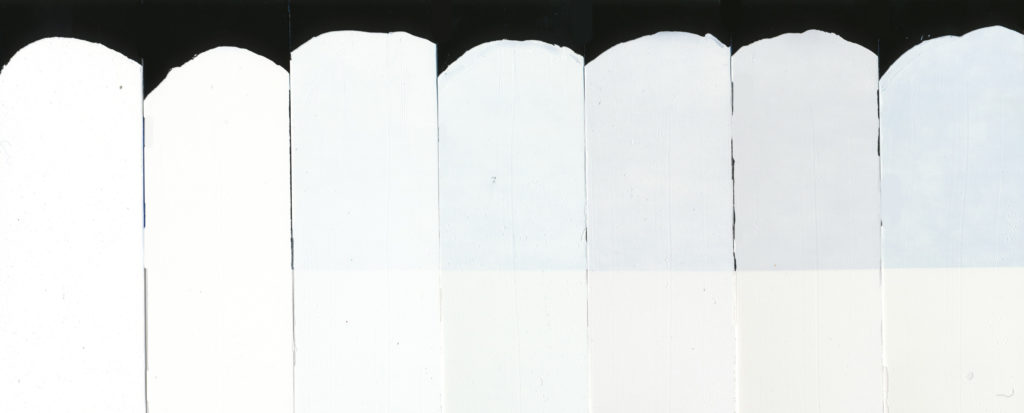
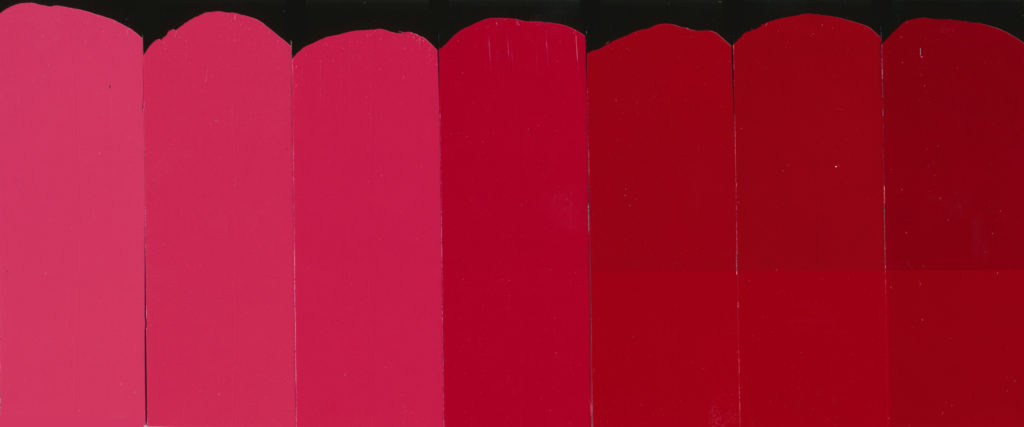
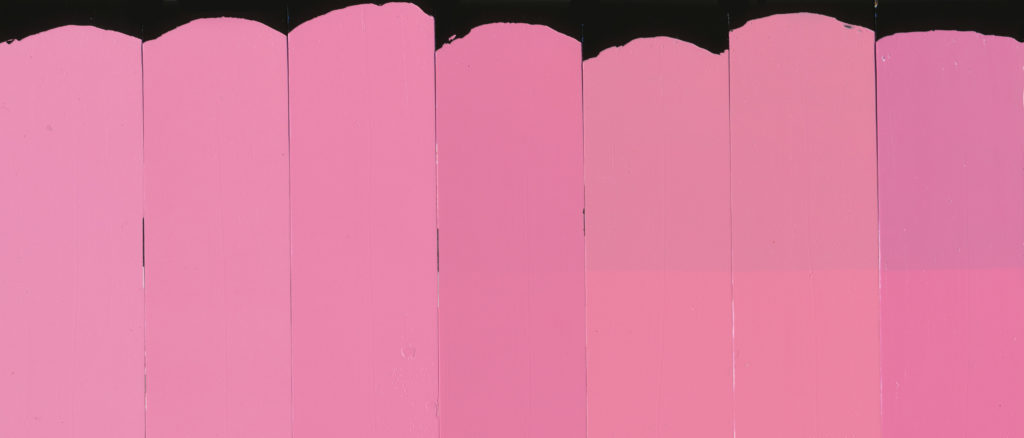
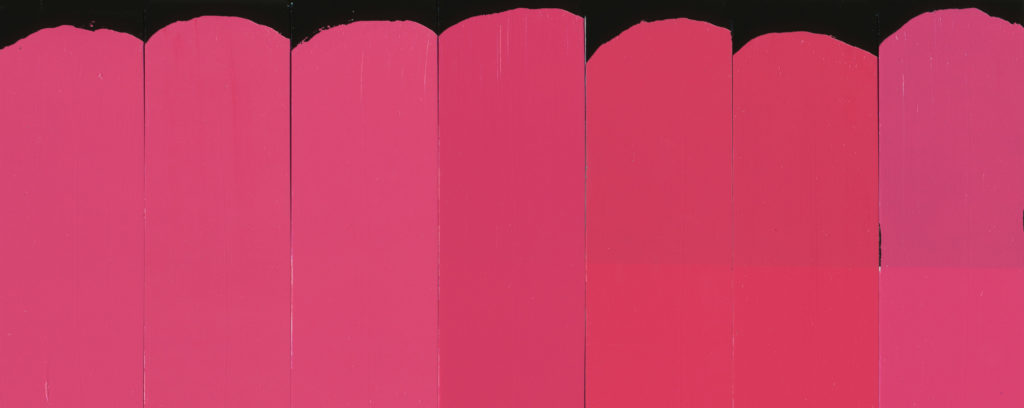
Eine Vielzahl von Farben gemischt etwa eins zu eins mit verschiedenen Weißen. Jede Karte ist von oben nach unten angeordnet: Vollton der Farbe, dünn geschabte Farbe, gemischt mit Flake White, Titanium White, Zinc White, Porcelain White. Die Farben, oben links: Kobaltgelb, Raw Siena, Mars Orange, French Ardoise Grey, French Terre Verte. Zweite Reihe von links: Viridian, Phthaloblau, Preußischblau, Manganviolett, Permanentes Karminrot. Untere Reihe von links: Ägyptisches Violett, Gebrannte Siena, Italienisches Rosa, Gebrannter Umber, Roher Umber
Bei Fragen oder Anmerkungen wenden Sie sich bitte an [email protected] oder rufen Sie 800-959-6543 (nur in den USA), 607-847-6154 oder in Europa 0049 (0)69-348 72 154 an.
Williamsburg Trocknungszeitübersicht: https://goldenhub.goldenpaints.com/storage/uploads/williamsburg-drytime-chart-091818.pdf
Williamsburg Farbkarte: https://www.williamsburgoils.com/products/colors
About Greg Watson
View all posts by Greg Watson -->Subscribe
Subscribe to the newsletter today!
No related Post

